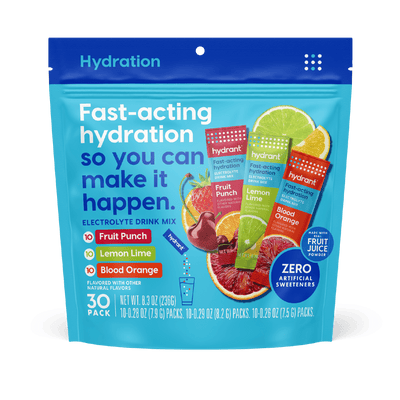Contrary to popular belief, dehydrated and dry skin aren’t the same. You may have similar symptoms from each, but there’s a key difference. While dehydrated skin is a lack of water in your skin, dry skin is a lack of natural oils in your skin. Think of it this way: dehydrated skin isn’t dry, in the same way that hydrated skin isn’t wet.
What does dehydrated skin look like?

If your skin is dehydrated, it might appear sunken or shadowy—you’ll notice a dull tone to your skin, or dark circles under your eyes. Where you have wrinkles or fine lines on your skin, they may look more defined, particularly around your face and the backs of your hands. Your skin may also be itchy, or appear more aged [1].
How to tell if your skin is dehydrated
You can test for dehydration in your skin with the simple pinch test. This test looks at skin turgor, or the elasticity of your skin. Turgor is the ability of your skin to be pulled out of shape, and then return to normal when released. Turgor is primarily affected by your skin’s water content.
Here’s how to test it: Gently pinch your skin (your cheeks, or the backs of your hands are the best places to try this) and watch what happens to your skin when you let go. If your skin bounces back quickly, and you can hardly tell you’ve pinched it, then it’s likely you’ve got well-hydrated skin. If it returns back to normal more slowly or is a bit wrinkly for a few moments after you’ve let go, it’s likely you’re dehydrated. This test, however, is best used in combination with other simple tests, for example the Nail capillary refill test where you bend your nail which whitens the nail bed and see how long it takes for the skin to turn pink again. You should also pay attention to how your skin looks and how the rest of your body feels [2].
There are different skin types a person can be born with: normal, dry, combination and oily skin. Your skin changes overtime because of aging and how you treat your skin. Other signs of dehydrated skin are:
- Appearance of fine lines
- Breakouts
- Itchiness
- Dullness
When the signs disrupt your daily activities, it’s recommended that you see a dermatologist!
How to hydrate your skin

Unfortunately, putting water on your skin isn’t enough to rehydrate it, no matter how many showers you take or how much moisturizer you use. Skin dehydration is a sign of overall dehydration—a lack of water in your body. Drinking water regularly throughout the day will help keep your skin hydrated and glowing. The recommended amount of water intake in a day is up to 11-15 cups! Another way to treat skin dehydration is with a humidifier or a good skincare routine.
Here are a few easy do’s and don’ts to implement into your skincare routine:
- do drink enough water throughout the day
- don’t put too many chemicals on your skin
- don't your face too often
- do limit the sunbathing
Each day you can lose up to 500 milliliters of water through your skin, and about 400 milliliters from exhaling, without accounting for extra loss from exercise, or abnormal circumstances [3]. Therefore, hydrating isn’t something you can do occasionally. For properly hydrated skin you need to make hydration a priority throughout the day. Alcohol, and high doses of caffeine, can also dehydrate you. Try to consume at least 2 litres of water or juice each day to hydrate properly, and for every caffeinated or alcoholic drink you have, drink another glass of water [4].

If you become dehydrated very quickly, then you’ll need to take action to hydrate rapidly, restoring water and salts to your body in the right proportions.
Reasons to have hydrated skin
As the largest organ of your body, your skin needs a lot of water. Healthy skin has water in the cells that make up the lower layers of your skin, between those cells, and between all the other fibers and molecules that make up the skin. Staying hydrated allows your skin to be healthy and resilient. Not only does skin perform better when hydrated, but hydrated skin looks and feels better.
Dry skin
Remember, dry skin is not the same as dehydrated skin. If you suffer from dry skin, it’s because of a lack of natural oils in your skin. This isn’t the same as dehydrated skin (a lack of water in your skin), and so requires different treatment. If you’re worried about particularly dry skin, you can try moisturizers and over-the-counter products, and if it continues, seek medical advice [5].
Is your routine dehydrating?
Are you concerned about your own hydration levels? Take the quiz below to find the best Hydrant for your hydration routine.
Writer: Ailsa McKinlay
Editor: Elizabeth Trelstad, www.hellobeaker.com
References
[1] La Roche-Posay. The Difference Between Dry & Dehydrated Skin. This article is written by a dermatologist for a skincare brand. It explains the difference between dry and dehydrated skin.
[2] U.S. National Library of Medicine. MedlinePlus. Skin Turgor. This website, part of the US National Library of Medicine, presents a simple summary of skin turgor in accessible, yet scientific language.
[3] “Regulation of Water Balance”, section 7.3 from the book An Introduction to Nutrition (v. 1.0). This textbook extract provides a great summary of water intake and loses from the body.
[4] HealthGuidance.org Caffeine and Dehydration. This article evaluates the evidence for caffine as a cause of dehydration.
[5] Healthline. What Causes Dry Skin? This website contains a huge variety of information about health. This short article summarizes dry skin conditions.
[6]. Best Electrolyte Powders is a website with a just-the-facts comparison between the five big electrolyte powder brands

















